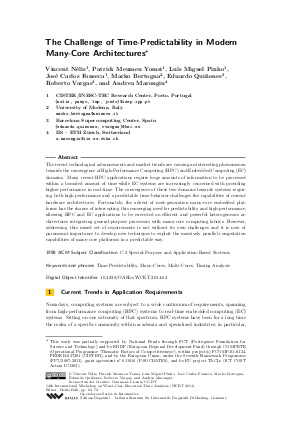The Challenge of Time-Predictability in Modern Many-Core Architectures
Authors Vincent Nélis, Patrick Meumeu Yomsi, Luís Miguel Pinho, José Carlos Fonseca, Marko Bertogna, Eduardo Quiñones, Roberto Vargas, Andrea Marongiu
-
Part of:
Volume:
14th International Workshop on Worst-Case Execution Time Analysis (WCET 2014)
Part of: Series: Open Access Series in Informatics (OASIcs)
Part of: Conference: Workshop on Worst-Case Execution Time Analysis (WCET) - License:
 Creative Commons Attribution 3.0 Unported license
Creative Commons Attribution 3.0 Unported license
- Publication Date: 2014-07-08
File

PDF
OASIcs.WCET.2014.63.pdf
- Filesize: 458 kB
- 10 pages
Document Identifiers
Subject Classification
Keywords
- Time-Predictability
- Many-Cores
- Multi-Cores
- Timing Analysis
Metrics
- Access Statistics
-
Total Accesses (updated on a weekly basis)
0PDF Downloads0Metadata Views
Abstract
The recent technological advancements and market trends are causing an interesting phenomenon towards the convergence of High-Performance Computing (HPC) and Embedded Computing (EC) domains. Many recent HPC applications require huge amounts of information to be processed within a bounded amount of time while EC systems are increasingly concerned with providing higher performance in real-time. The convergence of these two domains towards systems requiring both high performance and a predictable time-behavior challenges the capabilities of current hardware architectures. Fortunately, the advent of next-generation many-core embedded platforms has the chance of intercepting this converging need for predictability and high-performance, allowing HPC and EC applications to be executed on efficient and powerful heterogeneous architectures integrating general-purpose processors with many-core computing fabrics. However, addressing this mixed set of requirements is not without its own challenges and it is now of paramount importance to develop new techniques to exploit the massively parallel computation capabilities of many-core platforms in a predictable way.
Cite As Get BibTex
Vincent Nélis, Patrick Meumeu Yomsi, Luís Miguel Pinho, José Carlos Fonseca, Marko Bertogna, Eduardo Quiñones, Roberto Vargas, and Andrea Marongiu. The Challenge of Time-Predictability in Modern Many-Core Architectures. In 14th International Workshop on Worst-Case Execution Time Analysis. Open Access Series in Informatics (OASIcs), Volume 39, pp. 63-72, Schloss Dagstuhl – Leibniz-Zentrum für Informatik (2014)
https://doi.org/10.4230/OASIcs.WCET.2014.63
BibTex
@InProceedings{nelis_et_al:OASIcs.WCET.2014.63,
author = {N\'{e}lis, Vincent and Yomsi, Patrick Meumeu and Pinho, Lu{\'\i}s Miguel and Fonseca, Jos\'{e} Carlos and Bertogna, Marko and Qui\~{n}ones, Eduardo and Vargas, Roberto and Marongiu, Andrea},
title = {{The Challenge of Time-Predictability in Modern Many-Core Architectures}},
booktitle = {14th International Workshop on Worst-Case Execution Time Analysis},
pages = {63--72},
series = {Open Access Series in Informatics (OASIcs)},
ISBN = {978-3-939897-69-9},
ISSN = {2190-6807},
year = {2014},
volume = {39},
editor = {Falk, Heiko},
publisher = {Schloss Dagstuhl -- Leibniz-Zentrum f{\"u}r Informatik},
address = {Dagstuhl, Germany},
URL = {https://drops.dagstuhl.de/entities/document/10.4230/OASIcs.WCET.2014.63},
URN = {urn:nbn:de:0030-drops-46050},
doi = {10.4230/OASIcs.WCET.2014.63},
annote = {Keywords: Time-Predictability, Many-Cores, Multi-Cores, Timing Analysis}
}
Author Details
References
-
Dakshina Dasari, Bjorn Andersson, Vincent Nelis, Stefan M. Petters, Arvind Easwaran, and Jinkyu Lee. Response time analysis of cots-based multicores considering the contention on the shared memory bus. In Proceedings of the 2011 IEEE 10th International Conference on Trust, Security and Privacy in Computing and Communications, TRUSTCOM'11, pages 1068-1075, Washington, DC, USA, 2011. IEEE Computer Society.

-
Alejandro Duran, Eduard Ayguadé, Rosa M. Badia, Jesús Labarta, Luis Martinell, Xavier Martorell, and Judit Planas. Ompss: A proposal for programming heterogeneous multi-core architectures. Parallel Processing Letters, 21:173-193, 2011-03-01 2011.

-
T. Ungerer et al. MERASA: Multi-core execution of hard real-time applications supporting analysability. In IEEE Micro, Special Issue on European Multicore Processing Projects, volume 30:5, pages 66-75. IEEE Computer Society, aug 2010.

- Intel Corporation. Intel Many Integrated Core (MIC) Architecture, last access Nov 2013. URL: http://www.intel.com/content/www/us/en/architecture-and-technology/many-integratedcore/intel-many-integrated-core-architecture.html.
- Intel Corporation. Intel Xeon Phi, last access Nov 2013. URL: http://www.intel.com/content/www/us/en/processors/xeon/xeon-phi-detail.html.
-
David C. Luckham. The Power of Events: An Introduction to Complex Event Processing in Distributed Enterprise Systems. Addison-Wesley Longman Publishing Co., Inc., 2001.

-
T. Lundqvist and P. Stenstrom. Timing anomalies in dynamically scheduled microprocessors. In Proc. of the 20th IEEE Real-Time Systems Symposium, pages 12-21, 1999.

-
NVIDIA Corporation. NVIDIA CUDA Compute Unified Device Architecture, Version 2.0, 2008.

- OpenCL. The open standard for parallel programming of heterogeneous systems, 2013. URL: http://www.khronos.org/opencl/.
- parMERASA FP7 European Project - grant agreement 287519. Multi-Core Execution of Parallelised Hard Real-Time Applications Supporting Analysability, 2011-2014. URL: http://www.parmerasa.eu.
- Sutter, Herb. Welcome to the Jungle. URL: http://herbsutter.com/welcome-to-the-jungle/.
-
R. Tieman. Algo trading: the dog that bit its master. Financial Times, March, 2008.

-
Tilera Corporation. Tile Processor, User Architecture Manual, release 2.4, DOC.NO. UG101, May 2011.

